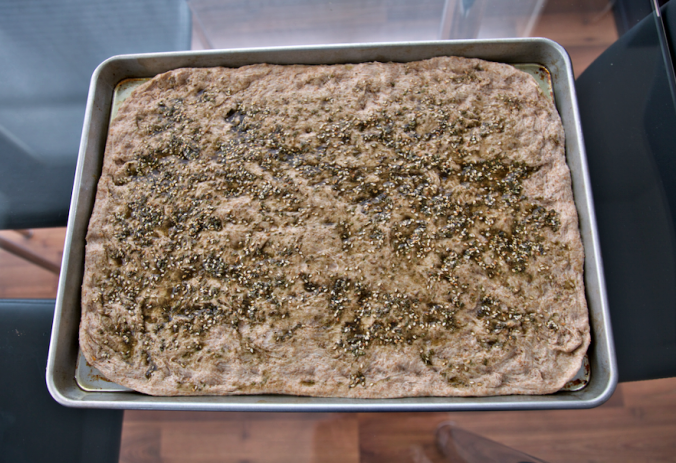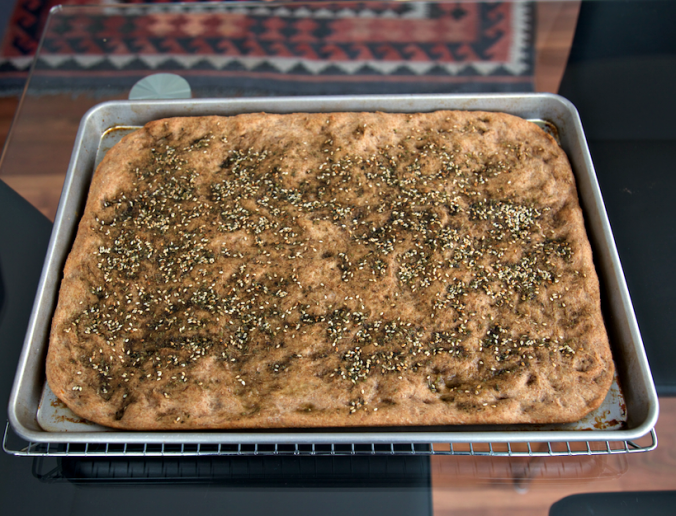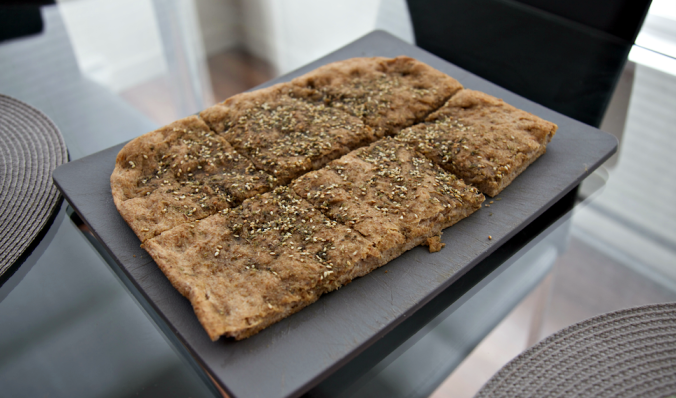One night a few weeks ago, I had planned to make some soup for dinner.
You know what goes well with soup?
Bread. (Duh.)
I was looking for a bread with a bit of substance – like the red pepper coques I made a little while ago – and settled on the recipe for Middle Eastern za’atar bread. I’d never heard of it before, but the write up in the Bread Illustrated cookbook tells me it’s a popular Arabic flatbread and assured me that “you can find za’atar in the international foods section of your supermarket or at Middle Eastern markets.”
Za’atar is a blend a thyme, sumac, and sesame seeds – and it is not easy to find in the international foods section of my local supermarkets. No problem, I thought – I’ll just make my own blend. Right – except where does one find sumac in Squamish? Not at Craig’s or Nesters, apparently. I probably should have gone and foraged in the woods. Except, wait – doesn’t sumac have poison ivy-like qualities?
I ended up making a blend of sesame seeds, thyme, oregano, and salt – so definitely NOT real za’atar. At this point, I have to wonder – am I even reviewing the real recipe? It reminds me of those recipes I see online – something like “Orange Poppy Seed Loaf”, and some brilliant commenter will write, “I’m allergic to citrus and we didn’t have any poppy seed, so I replaced it with banana and walnuts. I’m also gluten free so I omitted the flour. The recipe was way too gooey and I didn’t even get the taste of orange! One star.”
Back to the flatbread.

Pre-bake. In my Googling research, it appears that real za’atar bread has a thicker layer of topping. And, you know, actual za’atar.
The dough is pretty straightforward and the best part about it is this line: “Refrigerate for at least 24 hours or up to 3 days”. Three cheers for some flexibility with a bread recipe – I often find myself calculating backwards to try to time my bread just so (see: Auvergne crown). I was able to make this recipe two days in advance – woohoo!
Although it is made with bread flour, I found that the bread had a whole wheat kind of finish to it, including its darker colour throughout. I baked it as instructed and although I can’t tell you what actual za’atar tastes like, this bread still turned out well. It’s definitely a substantial, filling bread – the perfect complement to a light soup.

The book suggests serving it with yogurt – it was tasty both with and without.
Perhaps one day I will locate some za’atar and I can try this recipe anew. Actually, there is a new Middle Eastern restaurant in town that I’ve been meaning to check out – maybe I’ll see if they can spot me some sumac!

Lesson on sumac: All the berries of the red sumacs are edible. The white ones are poison. Sumac trees grow pretty much every where in North America, so I don’t know why we buy the berry. I buy sumac in very small quantities in a bulk food store, but I really should look into collecting some myself when I’m out for a walk. Find yourself a local forager. I’m sure you will be amazed at what you can get that way.
LikeLike
Words of wisdom as always! How do you know all of these things??! PS we desperately need a good bulk food store in Squamish.
LikeLike
Well, this one was easy. I needed sumac one day and I knew where to get some on trees, so I looked it up. I chickened out though and ended up skipping it, but every time I see a sumac tree, I feel like grabbing some.
LikeLike
The first time I made a recipe with za’atar I also had trouble finding it at the grocery stores. Like you I also tried to make my own and could not find sumac😝. What do you know one day grocery shopping I stumbled upon sumac. Maybe it will pop up for you!
LikeLike
I will 100% be on the lookout in the future – and when I find some, I’m definitely buying it! Maybe I should start a za’atar business? Seems like there’s a shortage!
LikeLiked by 1 person
Pingback: Baguettes! Or, Fou du Fafa | Out of Bounds Squamish